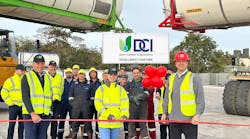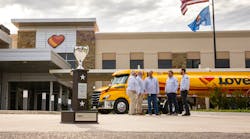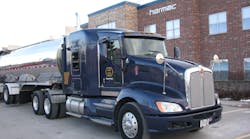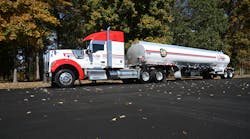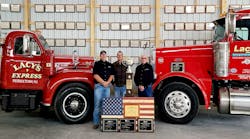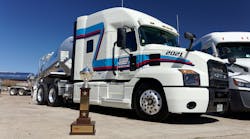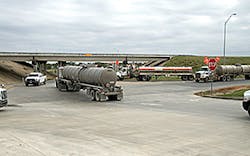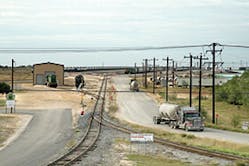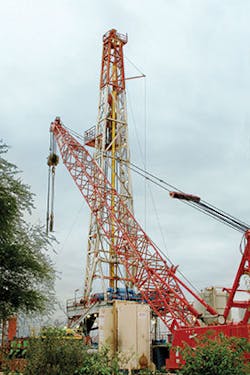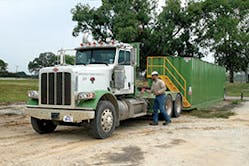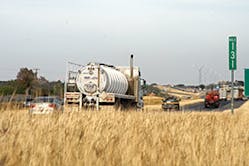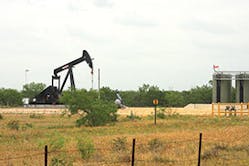BRING a group of oilfield truckers together and it doesn’t take long for the conversation to turn to the oilfield exemption for hours of service. That certainly was the case during the 2013 Oilfield Trucking Conference organized by the Association of Energy Service Companies (AESC) in October 2013 in Fort Worth, Texas.
The Federal Motor Carrier Safety Administration (FMCSA) generated plenty of controversy among oilfield haulers when it issued an updated regulatory guidance in August 2013. In short, the guidance stated that hours-of-service exceptions for oilfield operations apply only to very specific drivers operating specific types of equipment. The oilfield HOS exemption does not apply to truck drivers making routine deliveries of sand, water, and other products to oilfield sites.
In written comments delivered during the conference, FMCSA Administrator Anne Ferro defended the agency’s stand on the oilfield HOS exemption. Ferro’s comments came from a letter she sent to AESC to be read during the conference. She had to cancel her planned attendance due to federal budget constraints.
She stated in her letter that the rules for drivers servicing oilfield and natural gas sites have been on the books for more than five decades. “I recently had the opportunity to meet with Joyce Ryel (chairman of AESC’s oilfield trucking/fluid hauling committee) and other energy service trucking providers to hear their concerns about the hours-of-service rule and specifically the agency’s guidance on who can use the oilfield exception,” she wrote. “The rule gave me an opportunity to explain that these rules for drivers servicing oilfield and natural gas sites have been on the books for more than 50 years. More importantly, it was a chance to clarify that if any carrier believes that the current exceptions do not provide sufficient relief for their operations, they should consider submitting an application for an exemption.”
Ferro stressed in her letter that oilfield trucking safety is very important to FMCSA. “With our country’s successful drive toward energy independence and the dramatic increase in oil and gas drilling in many states, more truck traffic has emerged, particularly in small towns and on rural roads. Also, new drivers and companies are serving your growing industry. While new doesn’t mean unsafe, overall roadway safety has been impacted.
“FMCSA’s number one priority is safety. Everything we do—from enforcement to outreach to rulemaking—is focused on one goal: saving lives by reducing crashes. It is our job to help you make sure that commercial transportation to and from the drilling site is safe.”
CSA program
Topping the list of FMCSA safety tools is the Compliance, Safety, Accountability (CSA) program. CSA has proven to be a useful tool, helping FMCSA and the states make better use of their enforcement resources. It has driven down violations per roadside inspection by 14% and driver violations per inspection by 17%.
“CSA gives you (the fleets) current on-road performance data to help improve your own compliance and safety,” Ferro wrote. “It’s also a resource other companies use to make smart decisions about the providers they select to move product, service well sites, and move employees.
“CSA is an important program and we are committed to its continued improvement. That is why FMCSA redesigned the display of CSA data on its main website. We have other CSA actions in the pipeline, including a crash weighting analysis and the publication of a rule on safety fitness determination that will propose using inspection data to determine a company’s safety rating.”
Rollovers are a concern in the oilfield, and Ferro reviewed some of the rollover prevention initiatives that have been developed in cooperation with industry. “Thanks to a strong partnership with industry, we created a great training video on rollover prevention,” she said. “This tool is free to download from FMCSA’s hazmat page. The website also features a “Cargo Tank Rollover Prevention Toolbox” with the Rollover Prevention Driver Training video and a second video geared specifically for emergency responders. I want to thank the National Tank Truck Carriers (NTTC) and the Pipeline and Hazardous Materials Safety Administration (PHMSA) for their partnership in creating these resources.”
Ferro encouraged participation in FMCSA’s Pre-Employment Screening Program (PSP) and noted that more than 9,000 carriers have subscribed to the program. PSP allows companies to access driver inspection and crash records as part of the hiring process, which helps companies make more informed hiring decisions.
AESC page 2...
She noted that FMCSA soon will publish two proposals that will impact oilfield haulers, as well as the rest of the trucking industry. The first proposal would create a Commercial Driver’s License Drug and Alcohol Clearinghouse that would provide a secure place for employers to verify whether a job applicant has tested positive for controlled substances. The second regulatory initiative would mandate electronic logging devices on virtually all commercial vehicles.
Exception options
Kenny Jordan, executive director of AESC, was part of the industry group that met with Ferro and other DOT officials to discuss the oilfield hours-of-service issue. He reviewed some of the options being considered by industry groups.
“Prior to the latest FMCSA guidance, many oilfield service companies with trucking operations were operating under the oilfield HOS exceptions and had been doing so for many years,” he said. “This guidance created a lot of confusion that needs to be sorted out.
“The FMCSA guidance does provide a pathway for oilfield truck operators to file for a new HOS exception. However, any exception request must ensure the same level or better safety than the HOS rules currently in place. We never got a good answer on what would qualify, but we got a clear indication that FMCSA is receptive to a request.
“We need industry feedback so we can craft an oilfield HOS exception that has broad application for oilfield haulers. We need to communicate what the industry wants. I believe there is a genuine interest on the part of FMCSA to work with us, and they are talking to us.”
Various oilfield HOS exception possibilities are being discussed. These include exception requests for vehicles with sleepers and well sites with dormitories where drivers can rest off-duty.
Attorneys watching
John Conley, NTTC past president, asked: “Are there ways to avoid truck driver delays at well sites, so drivers can remain within the HOS requirements? Many of these drivers certainly are oilfield specialists. However, we have to keep in mind that litigation attorneys are watching this issue.”
Conley went on to discuss oilfield trucking in a broader sense. Trucks have been the workhorses in the shale plays, but not every truck is operated safely and responsibly.
“Promoting safe energy trucking is everyone’s responsibility from cradle to grave,” he said. “Remember, to the general public, your trucks are the oil and gas shale industry. “Oilfield service companies must incorporate the same safety culture and practices as in other tank truck and trucking energy sectors. You need to help spread the essentiality of safe trucking to developing our energy resources.
“Many of the people causing the truck-related problems in oilfield don’t attend association meetings, like this one, but what they do affects the entire trucking industry—both good and bad carriers.”
If the industry doesn’t do all it can to operate safely, the federal, state, and local enforcers will take a more active role. “The enforcement community already is looking at more speed limit reductions on roads and highways passing through oilfield areas,” Conley said. “That means more trucks will be needed, which means more traffic on already-congested roads. Keep in mind that Washington DC bureaucrats don’t know much about trucking in the oilfield. Many of the people at DOT (the Department of Transportation) have never worked in industry.”
Oilfield rollovers
Rollovers need special attention in the oilfield. This is a big deal, and it is one of the factors that will be examined in a study that the Department of Transportation is doing on oilfield transportation infrastructure.
“Rollovers are the number one issue at PHMSA,” Conley said. “Rollovers get a lot of attention in the news, and they are definitely on the radar for the regulators. They are looking at whether rollovers (and other accidents) were properly reported and how much the cleanup cost.”
Oilfield haulers need a good understanding of what it takes to run a safe operation. That starts with knowing the regulations that govern transport operations, especially when hazardous materials are involved.
“FMCSA is focusing more intervention resources on carriers involved in the transportation of placarded hazardous materials,” Conley said. To be subject to the hazmat threshold, a carrier must have at least two inspections on a vehicle transporting hazmat requiring placards in the last 24 months, with one inspection in the past 12 months, making up at least 5% of the motor carrier’s total inspections.
“Further, drivers need a tank truck endorsement if they are handling liquid cargoes (hazmat or non hazmat) of 1,000 gallons or more. This requirement applies to any vehicle—flatbed, van, tank, or whatever. DOT recently reiterated that they are serious about this requirement and will not back off on enforcement.”
AESC page 3...
Driver selection and training are critical factors. “Do your hiring and training programs differentiate you from your competitors?” Conley asked. “How do you help your drivers adapt to changing operating terrains? Who is responsible for monitoring your CSA scores? How good is your equipment specification, inspection, and maintenance process?”
Challenging environment
Steve Niswander, Groendyke Transport Inc vice-president of safety policy and regulatory relations and chairman of the Research Advisory Council at the American Transportation Research Institute (ATRI), said the oilfield presents one of the most challenging environments a truck driver will ever face.
“Much of the oilfield transportation takes place in rough conditions,” he said. “Drivers must contend with uneven road surfaces, little or no shoulder, and high weeds that make it difficult to determine the edge of the road. Drivers work long, hard hours, and operations continue day and night. It’s hard on experienced drivers, but a lot of drivers are coming to the oilfield with little or no tank experience.
“All of this contributes to rollovers and other vehicle accidents. Oilfield haulers need to do a better job of training drivers on the accident risks. You need to talk with your drivers about the rollover risk in particular.
“Training can be done in many ways, one of which is the poster program that NTTC developed with J J Keller Inc. The program includes a monthly poster, payroll stuffers, and skill cards. The payroll stuffers are critical because the most effective pressure on drivers to work safely comes from home. Groendyke spends about $10,000 a year on the program, which works out to about $11 a year per driver. It’s a worthwhile investment.”
Niswander added that groups like ATRI need to gain a better understanding of the challenges faced by oilfield haulers. “ATRI has begun studying oilfield trucking, but we need more data,” he said. “I would challenge the oilfield service sector to get involved, and help raise the information level.”
Data collection is something ATRI does well. One example is the rollover database, an online tool that shows where reported commercial vehicle rollovers are occurring. The biggest weakness in the database is due to the fact that 19 states don’t submit any information on truck accidents.
Fatal accidents
Rollovers are among the contributors to the relatively high motor vehicle fatality rate in the oilfield. Failure to use seatbelts is another factor.
In fact, the oil and gas extraction industry has the second highest motor vehicle fatality rate among all industry sectors. Transportation and warehousing has the highest motor vehicle fatality rate.
Highway crashes accounted for 30.8% of fatal accidents for oil and gas workers from 2003 to 2011. Of those fatality accidents, pickup trucks accounted for 51.5% and heavy- and medium-duty commercial vehicles made up roughly 39%.
“We need to look at more effective ways of reducing these fatality rates,” said David Boyd, director of health, Safety & environmental at HLI Energy Services. “We need to explore options for better driver selection, training, and management.”
He added that it isn’t surprising that pickup truck fatalities top the list. “There are less stringent requirements for pickup truck drivers,” he said. “Selection is not based on the same criteria as commercial drivers. Pickup truck drivers aren’t subject to HOS rules, and many of them work long hours. There is often a sense of urgency in the oilfield.”
Smaller companies seem to be more prone to vehicle accidents. Often, these companies have less oversight and lack the resources needed to effectively manage vehicle operations.
Safety workgroup
In an effort to address oilfield vehicle fatalities, the Oil and Gas Motor Vehicle Safety Workgroup was established in 2011. The workgroup is made up of representatives from industry, insurance, safety consulting, and the National Institute for Occupational Safety and Health.
The group looks for best practices that can be used to effectively reduce accident and fatality rates. One such best practice is the use of in-vehicle monitoring systems.
Boyd said his company is using a monitoring system that records date, time, speed, acceleration, deceleration, and safety belt use. It measures driver performance against a predetermined set of parameters.
“Fleets can see immediate and positive effects on driver performance,” he said. “These systems have reduced crash rates by 50% to 93%, they have cut speeding by 60%, and they are reducing miles driven by 8% to 20%.
To be most effective, the vehicle monitoring system must be part of the overall fleet safety program. The monitoring devices should be installed in every vehicle in the fleet, and everyone who drives should be tracked.
Boyd recommended starting with a pilot test in a small part of the fleet. Find drivers who are willing to buy into the program and enlist them as advocates. Resist the urge to use the technology as a policing tool.
“The technology works best if it is used as a tool for retraining,” he said. “The biggest objective should be to identify the root cause of driving safety problems. You can’t look at just the vehicle driver. You also have to monitor communications between vehicle drivers and supervisors. Supervisors must be held responsible for the instructions they give to their subordinates.”
Oilfield fleet operators can benefit from custom-designed journey management systems that assess driving risk exposures associated with a company’s unique operations. The journey management process makes informed decisions about who drives, what they drive, when they drive, where they drive, how they drive, why.
Plans should be fit-for-purpose to address the company’s local exposures—weather, visibility, traffic, roads, and routine and non-routine routes. The program must go well beyond minimum regulatory requirements to be most effective. ♦

